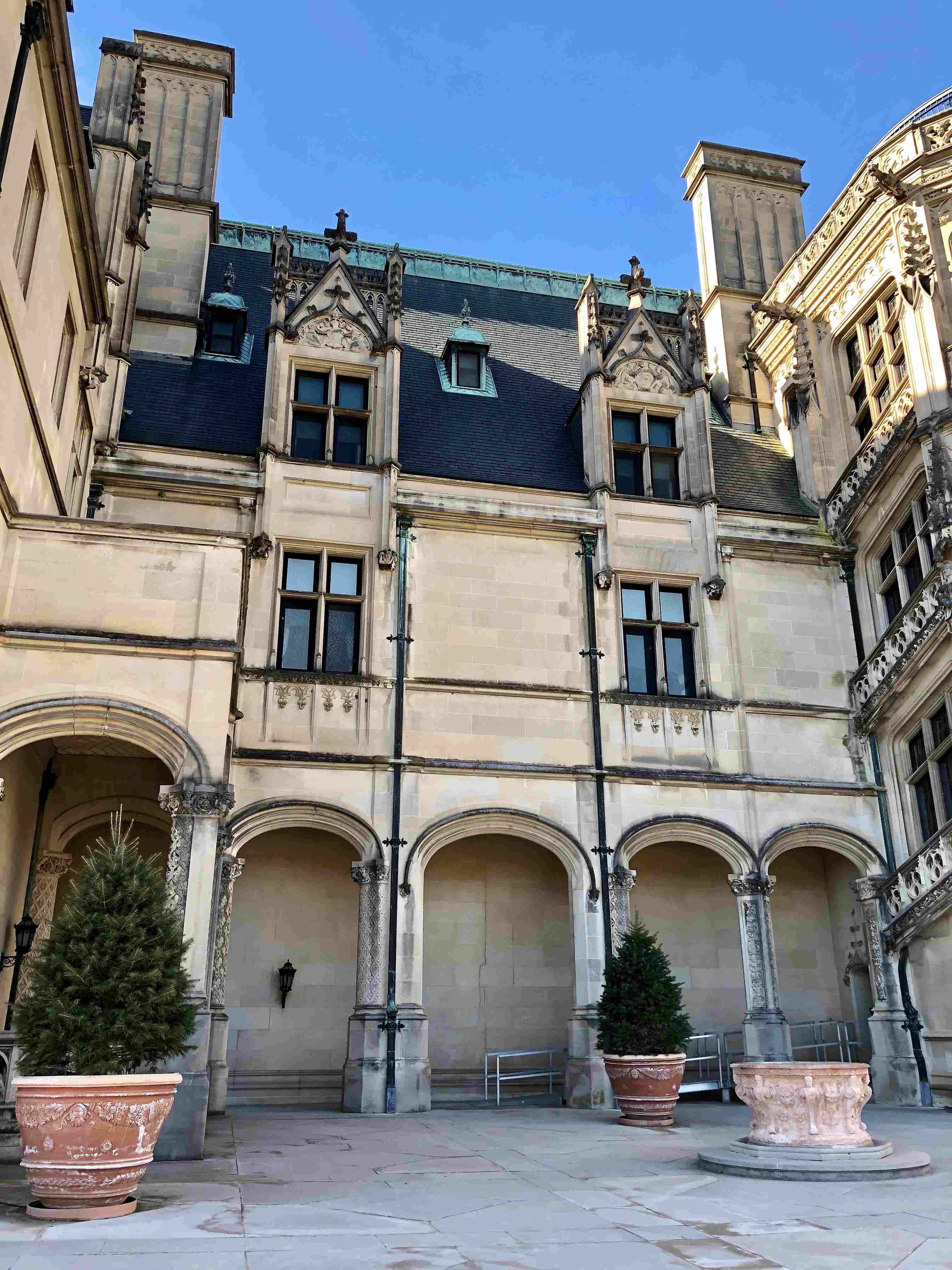The fish fountain at Biltmore Estate, officially known as the ‘Boy Stealing Geese’ fountain, is a captivating centerpiece in the Winter Garden. Created by Viennese artist Karl Bitter, this marble and bronze masterpiece was installed during the estate’s construction between 1889 and 1895. The fountain showcases a boy stealing geese, reflecting George Vanderbilt’s refined taste and the Victorian era’s appreciation for European art. Located in the serene Winter Garden, the fountain is surrounded by stone archways, offering visitors a glimpse into the opulent world of America’s Gilded Age.
What is the History of the Fish Fountain at Biltmore Estate?

The ‘Boy Stealing Geese’ fountain, often referred to as the fish fountain at Biltmore Estate, has a rich history dating back to the estate’s construction. Here are key points about its origins:
- Installation Period: The fountain was installed between 1889 and 1895, during the construction of Biltmore House.
- Artist: Created by renowned Viennese artist Karl Bitter.
- Commissioning: George Washington Vanderbilt personally selected this piece as part of his extensive art collection.
- Artistic Movement: Reflects the late 19th-century trend of incorporating European art into American estates.
The fountain’s installation coincided with the broader development of Biltmore Estate, which was designed to be a self-sustaining and luxurious retreat. Its presence in the Winter Garden underscores the Vanderbilt family’s commitment to creating spaces that seamlessly blended art, nature, and architecture.
What are the Design Features of the Fish Fountain?

The ‘Boy Stealing Geese’ fountain, commonly known as the fish fountain at Biltmore Estate, boasts several distinctive design features:
- Materials:
- Marble base
-
Bronze sculptures
-
Central Sculpture:
- Depicts a boy in the act of stealing geese
-
Highly detailed craftsmanship
-
Water Features:
- Multiple water spouts
-
Gentle cascading effect
-
Surrounding Elements:
- Circular pool
- Stone rim for seating
The fountain’s design complements the Winter Garden’s overall aesthetic, creating a harmonious blend of art and nature. Its placement within the circular room enhances its visual impact, making it a focal point for visitors exploring the estate’s interior.
Where is the Fish Fountain Located Within Biltmore Estate?
The fish fountain, officially named the ‘Boy Stealing Geese’ fountain, occupies a prime location within Biltmore Estate:
- Specific Location: Center of the Winter Garden
- Building: Inside Biltmore House
- Floor: Ground floor
- Nearby Rooms:
- Grand Staircase
- Banquet Hall
- Tapestry Gallery
The Winter Garden, housing the fountain, serves as a transitional space between the house’s formal rooms and the outdoor gardens. Its strategic placement allows visitors to appreciate the fountain from multiple angles as they move through the estate.
How Can Visitors Experience the Fish Fountain?
Visitors to Biltmore Estate can experience the fish fountain in several ways:
- Self-Guided Tours:
- Available daily
- Included in general admission
-
Allows for leisurely observation
-
Guided Tours:
- Expert-led
- Provides historical context
-
May require additional fee
-
Special Events:
- Seasonal decorations (e.g., Christmas at Biltmore)
-
Evening candlelight tours
-
Photography:
- Non-commercial photography permitted
- Tripods and flash not allowed
| Tour Type | Duration | Included in Admission | Additional Info |
|---|---|---|---|
| Self-Guided | Flexible | Yes | Audio guide available |
| Expert-Guided | 90 minutes | No | Reservation required |
| Behind-the-Scenes | 60 minutes | No | Limited availability |
Visitors are encouraged to take their time in the Winter Garden to fully appreciate the fountain’s details and its role in the overall design of Biltmore House.
What is the Significance of the Fish Fountain in Biltmore’s Art Collection?
The fish fountain, or ‘Boy Stealing Geese’ fountain, holds a special place in Biltmore’s extensive art collection:
- Artistic Value:
- Represents high-quality European sculpture
-
Showcases Karl Bitter’s renowned craftsmanship
-
Historical Significance:
- Reflects George Vanderbilt’s discerning taste
-
Exemplifies Gilded Age art collecting practices
-
Thematic Relevance:
- Connects indoor and outdoor spaces
-
Embodies the estate’s focus on blending nature and art
-
Conservation Efforts:
- Subject of ongoing preservation work
- Demonstrates Biltmore’s commitment to maintaining its heritage
The fountain serves as a tangible link to the estate’s original vision, offering visitors a glimpse into the artistic preferences of America’s industrial elite at the turn of the 20th century.
How Does the Fish Fountain Contribute to the Winter Garden’s Atmosphere?
The fish fountain plays a crucial role in shaping the Winter Garden’s unique ambiance:
- Visual Focal Point: Draws the eye and anchors the circular room
- Auditory Element: Gentle water sounds create a soothing environment
- Natural Connection: Brings a sense of the outdoors inside
- Artistic Inspiration: Encourages contemplation and appreciation of fine art
- Spatial Definition: Helps define the room’s purpose as a transitional space
By combining these elements, the fountain transforms the Winter Garden into a multisensory experience, inviting visitors to pause and immerse themselves in the estate’s refined atmosphere.
What Maintenance and Conservation Efforts Preserve the Fish Fountain?
Biltmore Estate employs rigorous maintenance and conservation practices to preserve the fish fountain:
- Regular Cleaning:
- Weekly gentle cleansing
-
Use of non-abrasive materials
-
Water Quality Management:
- pH balance monitoring
-
Filtration system maintenance
-
Structural Inspections:
- Annual assessments by conservators
-
Checks for cracks or wear
-
Restoration Projects:
- Periodic touch-ups to bronze elements
-
Marble base resealing as needed
-
Environmental Controls:
- Humidity regulation in the Winter Garden
- Temperature monitoring to prevent material stress
These efforts ensure that the fish fountain remains a vibrant and functional piece of art for future generations of visitors to enjoy.
How Does the Fish Fountain Compare to Other Water Features at Biltmore Estate?
While the fish fountain is a standout feature, Biltmore Estate boasts several other notable water elements:
| Feature | Location | Style | Primary Material |
|---|---|---|---|
| Fish Fountain | Winter Garden | Indoor, Sculptural | Marble and Bronze |
| Italian Garden Pools | Outdoor Gardens | Formal, Geometric | Stone |
| Bass Pond | Lower Grounds | Natural, Landscaped | Earthen Dam |
| Lagoon | Near House | Naturalistic | Concrete and Stone |
Key differences:
– Scale: The fish fountain is more intimate compared to larger outdoor features.
– Artistic Focus: It has a stronger emphasis on sculpture than other water elements.
– Accessibility: Being indoors, it’s viewable year-round regardless of weather.
– Historical Context: Directly connected to the house’s original furnishings and decor.
Each water feature contributes uniquely to the estate’s overall design, with the fish fountain standing out for its artistic merit and indoor setting.
References:
1. Biltmore Estate Official Website
2. National Park Service – Biltmore Estate
3. The Biltmore Company: A National Historic Landmark
4. American Gilded Age Mansions
